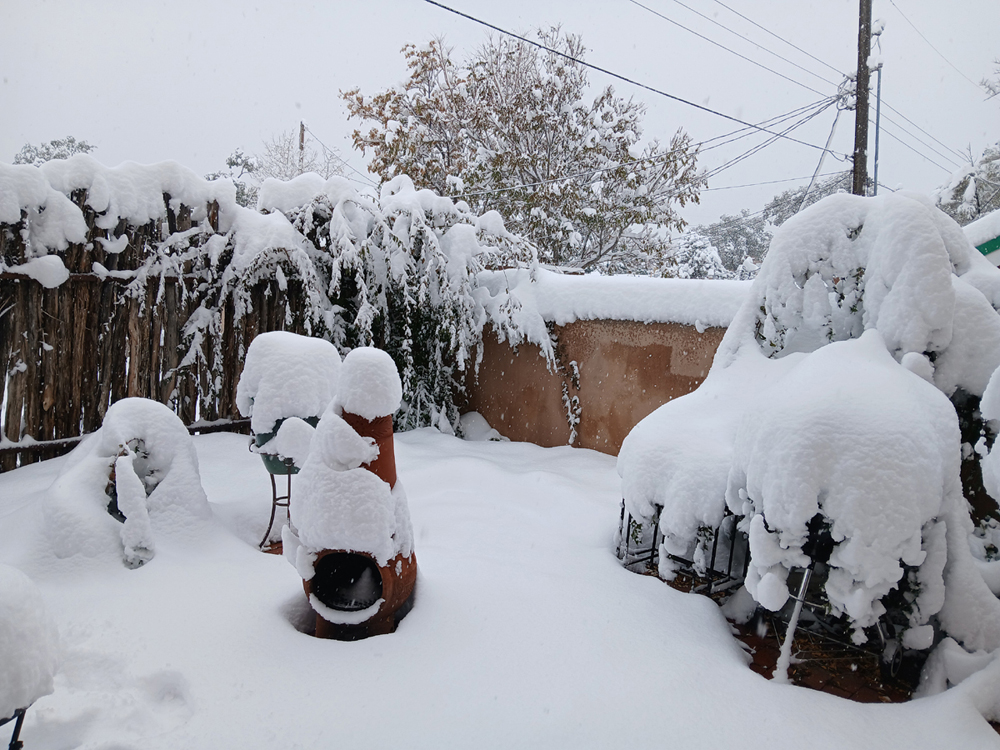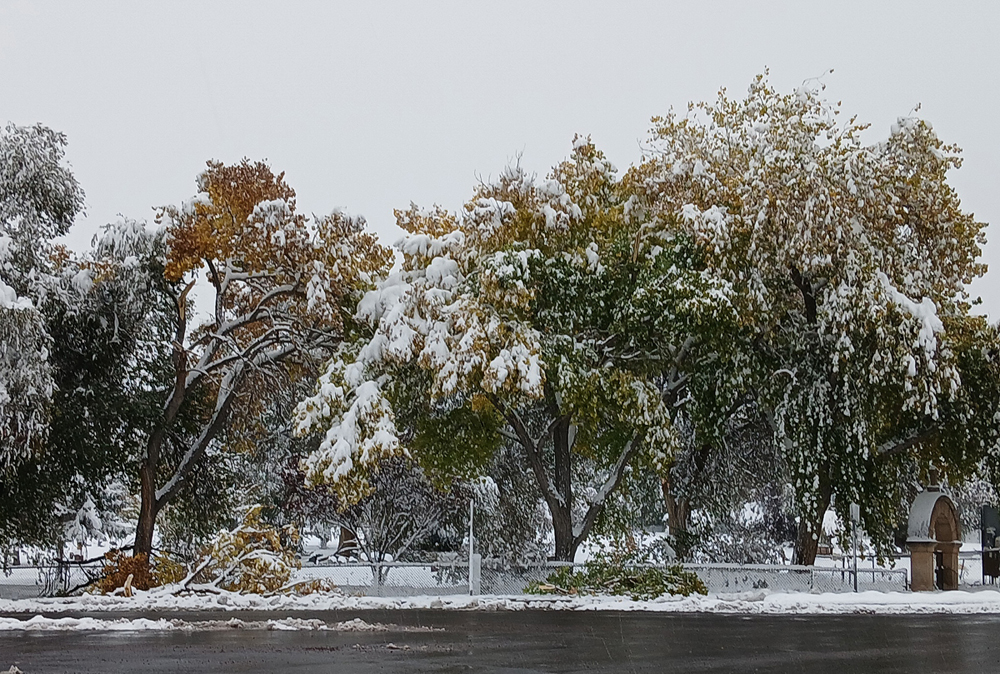

This was taken a little north of the Martinez Canyon trailhead, along US 84. As I got down to lower elevation near Ghost Ranch, the snow was not accumulating on the ground but was on some of the vegetation. Almost looked like white flowers along the road, but it was snow. Here is a picture:

There was a lull in the snow between Abiquiu and Espanola, but as I nreared Espanola, the sky darkened and precipitation resumed. At first, at that lower elevation, it was rain, but it mixed with snow and then as the road climbed into the hills north of Santa Fe, it became all snow, and near the Santa Fe Opera, the road became slushy and snow-covered. I followed a plow from there to the 599 bypass, in heavy snow and low visibility. By the time I reached Santa Fe, there was around 4 inches on the ground in grassy and elevated areas, with less on the roads, but still they were snow-coverd or slushy in some areas. Once I got the car unloaded, I was ready for dinner. Not wanting to cook after the drive, I headed out to eat but the first 3 restaurants I tried, all in DeVargas Center, were closed. I thought just because of the storm, but in hindsight, they may not have had power. That did not occur to me, since the Market Street grocery store was open and doing business. But grocery stores usually have generators, so the food doesn't spoil. When I did finally find a restaurant open, I did hear people talking about the power having been out at their home, but had come back on. After dinner, the trees were really pretty with the way they were coated with snow, and I got this picture during a quick stop at Walgreens:

Up to that point, I had been mainly focused on the photogenic nature of this snowstorm and on getting pictures. But after leaving Walgreens, the problematic aspects of the storm rapidly became apparent. I had to hit the brakes rather hard as I realized that a stop light was completely out - not even blinking. This needs to be treated as a four-way stop. Often during power outages, the traffic signals blink, but this one was dead out. And more after that. The DeVargas center was totally dark, except for the Sprouts store. At first I thought it was strange that one business would have power when all the others did not, but later I remembered what I mentioned above - grocery stores have generators. So probably the only places that were open were the two grocery stores on opposide sides of the shopping center, because they had generators. By the time I got back to our condo, the snow accumulation was up to around 6 inches - two more inches since I had left to get dinner. The snow continued to fall through the evening at a moderate to heavy pace, with around 8 inches by the time I went to bed around 11 or 11:30. Here are a pictures of our back patio and yard:


The rather ghostly looking thing in the center of the second picture is snow accumulated on the branches of a small tree, which were pulled down over our barbecue grill and a table. Notice also in that picture the accumulation of snow on the power and telephone lines. I think there was around 7 inches of snow when this picture was taken. I was increasingly concerned that the power would go out, but it stayed on overnight.
By the next morning around 9 a.m., 11 inches of snow had accumulated on tabletops and other elevated surfaces. Maybe more like 6 on paved surfaces, where some melting had occurred. Here is a picture I took of the patio and backyard around 9; note that there is quite a bit more snow than the night before.

Then, around 9:10 a.m., the power went out. I reported the 11 inches of snow and the power outage to NWS Albuquerque, and then did some shoveling. The snow lightened after around 9 a.m., and then quit entirely for a while in the early afternoon. I ran some errands - the roads were actually not all that bad, except where they got blocked by falling tree limbs - and by the time I finished the snow was back, this time in the form of a shower of graupel (snow pellets). But that did not last long in Santa Fe, and my total accumulation for the storm was 12 inches.
This was an unusually heavy snow for November in New Mexico, and in Santa Fe, the heaviest in quite a few years. And the fact that leaves were still on the trees was a big problem. Driving through the Abiquiu area on the way to Santa Fe, I had been struck by how brilliant the fall color still was on the cottonwood trees, even looking at them through falling snow. In Pagosa, the leaves are mostly off the trees now, and they often are by this time in Santa Fe as well, but they seem to be later this year and that could be the trend due to the warming climate. It had been quite warm in NM until just before the storm. But heavy snow with the leaves still on the trees is a big problem, because it brings down a lot of limbs, some of which fall on power lines. At the peak, there were 50,000 customers without power, largely in the Santa Fe and Albuquerque areas, but to some extent all over the parts of northern New Mexico in and close to the Sandia/Manzano, Sangre de Cristo, and Jemez Mountains. And remember that each customer is a home or business, so the number of people affected is two or three times the 50,000 figure. Here is a picture I took at the intersection of Paseo de Peralta and Guadalupe that illustrates why there were so many tree and power problems:

There were at least five large branches down at that one location, and others nearby. With lots of leaves still on the trees, as you can see in the picture, they just could not hold the weight of the snow. This was especially a problem with the bigger, older trees that there are a lot of in the central part of the city, but there were some limbs down all over. Fortunately the power was only out for about 3 hours at our condo, but on the evening of November 8, local news reported that there were people in Albquerque, Santa Fe, and Espanola whose power had gone out Wednesday evening or Wednesday night and was still out Friday evening. By then, it has gone from an inconvenience to a serious situation, especially when you go without heat for two days and for those who need power for medical devices. Food spoilage can also be an issue, but when it is as cold as it was in Santa Fe, you can put food from the refrigerator or freezer outside in boxes or coolers in a shady place and it will be fine. I did that, but an hour or so later the power came back on, so I was able to put it back in the fridge and freezer once they had run long enough to get back down to their normal temperature.
For the most part, driving was not horrible in the Santa Fe and Albuquerque areas, though it did have its challenges. East and northeast of there was a different story. I-40 was closed in places between Albuquerque and Santa Rosa, and I-25 at various times was closed between Santa Fe and Las Vegas (which got two feet of snow) and from Las Vegas to the Colorado State Line. (And later, from there northward to Pueblo, CO.) On US Highway 64 between Clayton and Des Moines, NM, there was a pileup of 100 vehicles after a semi truck jacknifed and other drivers could not stop. There and along Interstate 40, people had to be rescued and taken to nearby towns, and there were reports that some spent the night stuck on I-40.
This storm was the result of a low pressure system that moved in from the northwest, and then became cut off from the jetstream and stalled over east central Arizona on November 6, drifting only to central New Mexico by the morning of November 8. This set up a prolonged upslope push of Gulf of Mexico moisture to areas near and east of the mountains of New Mexico. By the afternoon of November 8, the storm was drifting northeast toward the southeast corner of Colorado, continuing to pump in the Gulf moisture, but now into Colorado. Parts of Colorado got two periods of heavy snow, one when the storm first moved south and southeast over western Colorado the night of November 5 and morning of November 6, then again when the storm moved northeast on November 8. This produced similar conditions in the Front Range and eastern plains of Colorado to what had occured in New Mexico, resulting of closures of large sections of Interstates 25 and 70. The snow amounts with this storm were truly impressive. While Santa Fe got a foot (and up to 15 inches in some areas) and Las Vegas, NM got two to two and a half feet, there were places in New Mexico that got 3 feet, both in the Sandia Mountains and the eastern plains. There was even a report of 40 inches near Angel Fire. Areas northeast of Fort Garland, in southern Colorado off US 160 in the Forbes Park area, got over 3 feet of snow, and I saw an unofficial report on TV of over 40 inches. This was updated on November 9 to a total of 53.3 inches! There was also a report of 54.9" near San Isabel and a report of 44 inches near Trindad, CO. Reports of a foot and a half to two feet of snow were commonplace along I-25 in both northeast NM and central and southern CO, and along and east of I-25 blizzard or near-blizzard conditions occurred with very low visibility and big drifts. It even extended east into the western parts of the TX and OK Panhandles, where up to 2 feet of snow were reported. An upside was that many ski areas got 20-36 or more inches of snow, leading a couple in New Mexico to announce their earliest-ever openings. And of course, there area always benefits to moisture in the West. Still, by any definition, this was a storm for the record books!
A news report on the storm from the Santa Fe New Mexican can be found here.
Return to 2024-25 Winter Weather Observation Page